Homeowners Insurance
Christmas Hazards in 2021: Americans Report Tree Injuries, Fire Risks, Frisky Pets and Sticker Shock
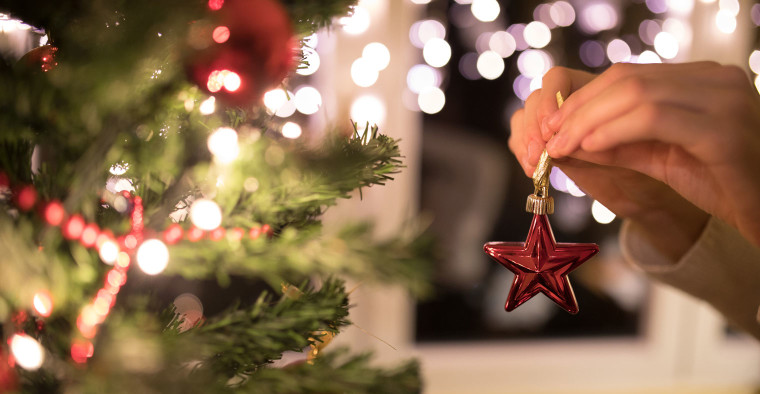
’Tis the season to be jolly — but also the season to be careful, as 10% of Americans report injuries while putting up a Christmas tree. While that percentage seems high, it’s down from 20% last year, or similar to 9% in 2019, pre-coronavirus pandemic.
This injury rate is just one discovery in ValuePenguin’s latest survey on holiday season issues. The survey also finds that more than a third (34%) of Americans won’t use Christmas tree lights as often this season because of increased electric costs. That’s a bit of a holiday "bah humbug" amid everything going on in the world, but it’s a reality in 2021.
- Key findings
- 1 in 10 Americans report Christmas tree injuries, and some admit to drunken decorating
- The age-old safety debate about artificial vs. real Christmas trees — and what Americans are planning to use in 2021
- Is it naughty or nice to leave Christmas tree lights on overnight?
- Rising utility bills could be real Grinch this holiday season
- Methodology
Key findings
- Christmas tree injuries have dropped to pre-pandemic levels. This year, 10% say they’ve been injured setting up a tree, down from 20% last year but similar to 9% in 2019. One possible injury source: 18% admit to setting up their tree while they were drunk.
- 51% of consumers think artificial Christmas trees are safer than real ones, but are they right? Real trees are a bigger fire hazard, but both types come with potential risks.
- Nearly 70% of Americans have left Christmas tree lights on overnight, which can be a fire hazard. Going further, 10% use lights that are at least 7 years old, so be sure to check the wiring first. To avoid accidents, some consumers (24%) use smart home devices to manage lights.
- Pets and Christmas trees don’t always mix. 72% of pet owners say their pets have knocked down their Christmas tree or knocked off ornaments — and nearly half (49%) of people in that group report damage.
- Electricity bill sticker shock is another possible holiday hazard in 2021. This year, 34% plan to use Christmas tree lights less often due to increased electricity costs.
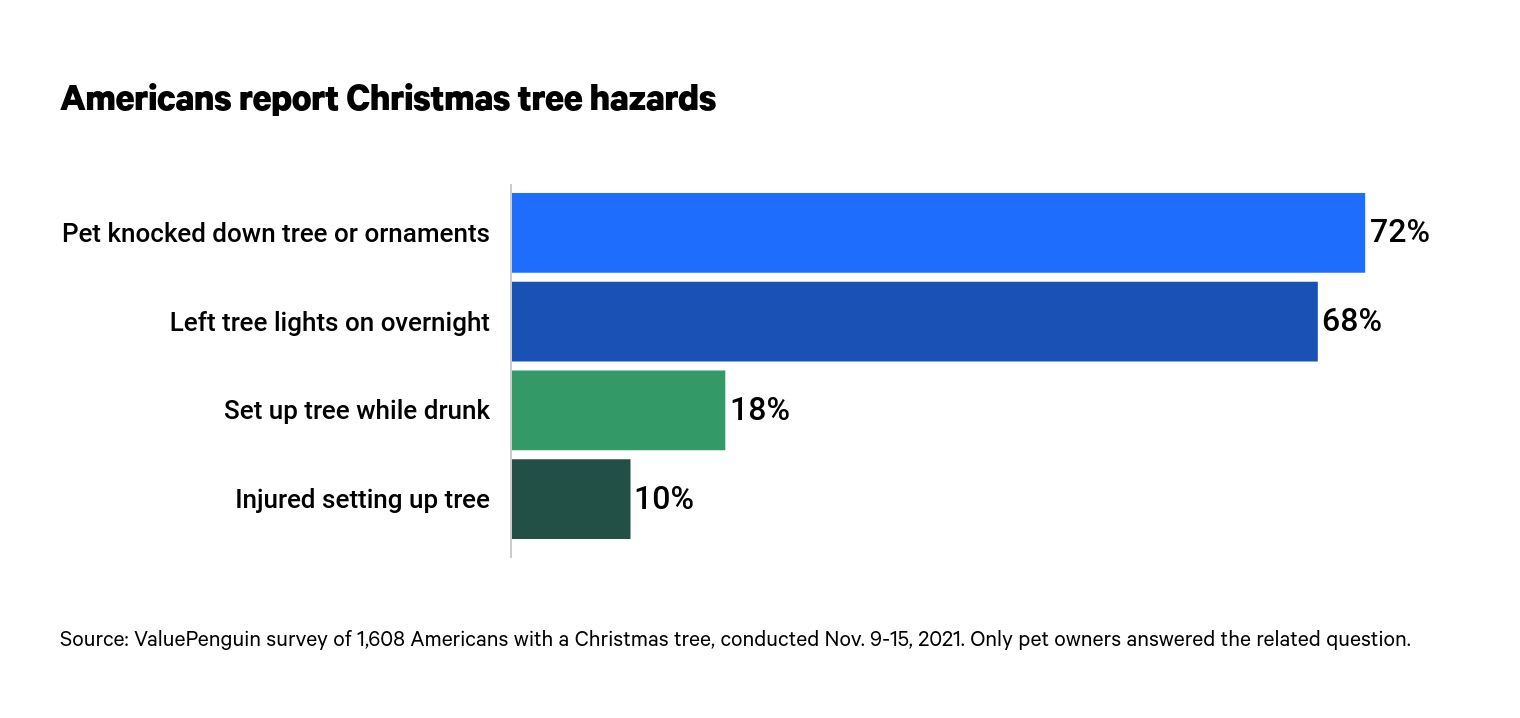
1 in 10 Americans report Christmas tree injuries, and some admit to drunken decorating
While 10% of Americans report Christmas tree injuries, according to the latest ValuePenguin survey, that’s half of the 20% rate at which people reported the same in 2020. But it’s more similar to the 9% share who said the same in 2019 before the coronavirus pandemic.
From June 2021: Despite pandemic lockdowns that kept many Americans inside, fewer home improvement and maintenance injuries were recorded.
As it turns out, Gen Zers (ages 18 to 24) sustain more Christmas tree injuries than any other generation, at 22%. For comparison, 12% of millennials (ages 25 to 40), 5% of Gen Xers (ages 41 to 55) and 3% of baby boomers (ages 56 to 75) report injuries caused by tree decorating.
Why so many injuries while trimming the tree? Some decorators may hit the alcoholic eggnog a bit too hard, with 18% of respondents admitting to setting up their tree while they were drunk. This percentage rises for millennials (27%) and Gen Zers (20%). And the rate of men who have done so (25%) is nearly double that of women (13%).
Personal liability coverage within a homeowners insurance policy would likely cover bodily injury or property damage after a Christmas tree mishap, but that coverage may be limited if alcohol is involved. It might be best to stick with a steamy mug of hot cocoa while decorating your tree — especially if a ladder is involved.
The age-old safety debate about artificial vs. real Christmas trees — and what Americans are planning to use in 2021
While faux trees lack that charming pine scent, plenty of consumers are willing to forgo that for a safer (and easier) alternative. More than half (51%) of consumers — and 58% of Midwest residents — believe that artificial Christmas trees are safer than real ones. Are they right?
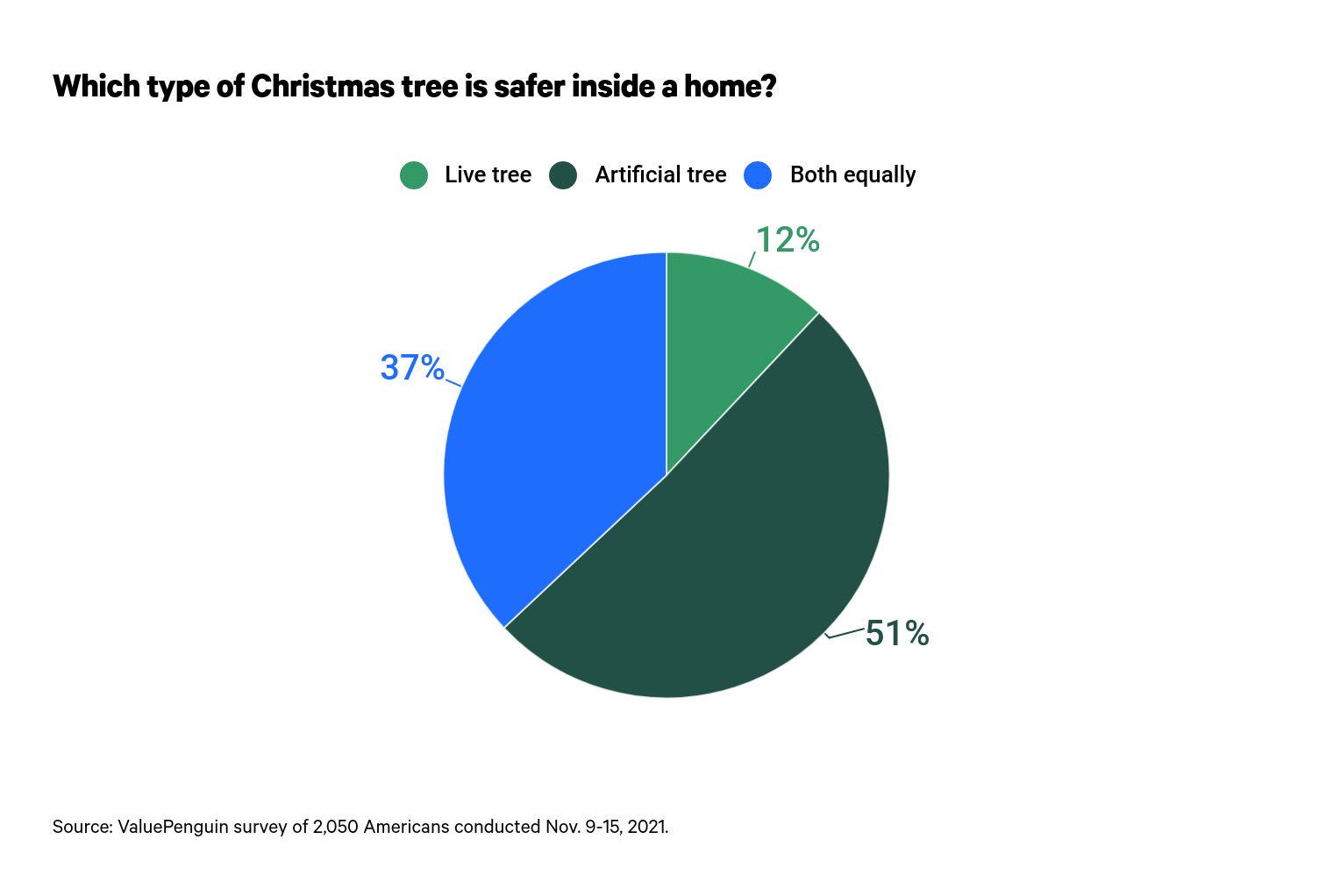
The artificial tree fans may be onto something — real trees are typically a bigger fire hazard than artificial ones, but both types come with potential safety risks. (Think overloaded sockets, faulty lights, overeager pets, lacerations from broken bulbs, etc.)
From 2014 to 2018, fires that began with Christmas trees caused $10.3 million in direct property damage, according to the National Fire Protection Association (NFPA). The danger associated with Christmas trees is one of many reasons why a solid homeowners or renters insurance policy could rise to the top of your holiday wish list this year.
The majority of consumers will have a Christmas tree in their home this year, with 70% reporting they’ll have one and 8% planning on having more than one. (Interestingly, 20% of Gen Zers plan to have more than one tree — the only generation with a percentage in the double digits.) That said, a slightly lower percentage of Americans will opt for live trees this year — 21%, compared with 24% last year. Another 6% of consumers will utilize both live and artificial trees.
Younger generations favor live trees more than Gen Xers and baby boomers do. And parents with kids younger than 18 are more likely to choose a live tree than people without young children at home. Who can resist making a little real holiday magic for their little ones?
And once the holidays are over, the tree drama doesn’t stop. Just 25% will bring the tree to a recycling center — the recommended suggestion from the NFPA. Another 28% will set it outside for trash pickup, and 22% will burn it, which could land some consumers on the naughty list next year.
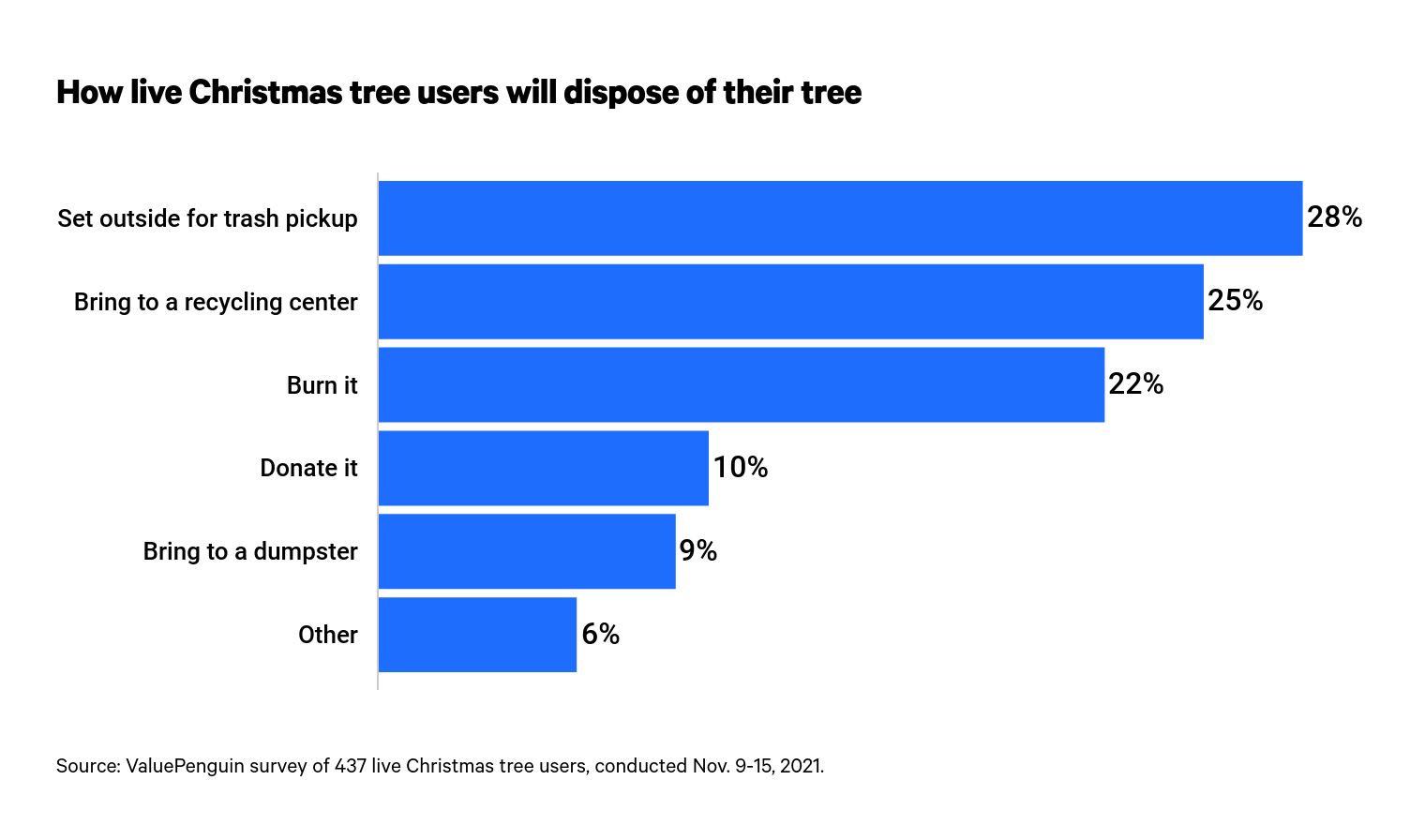
Is it naughty or nice to leave Christmas tree lights on overnight?
It looks like Santa has some naughty behavior to watch. The majority of Americans (68%) admit to having left Christmas tree lights on overnight, which can be a fire hazard. (To be fair, ValuePenguin didn’t ask whether it was accidental.) But men are more guilty of leaving lights on overnight (72%) than women (65%). And despite Gen Xers only being 18 to 24 years old, 86% within this age group admit to leaving the lights on, versus 43% of baby boomers.
From September 2021: The average cost of home insurance rises 27% after a fire.
To make matters worse, these lights may not be up to snuff, as 10% of consumers use lights that are at least 7 years old. Double-check the wiring before you decorate the tree, especially if you’re using older lights.
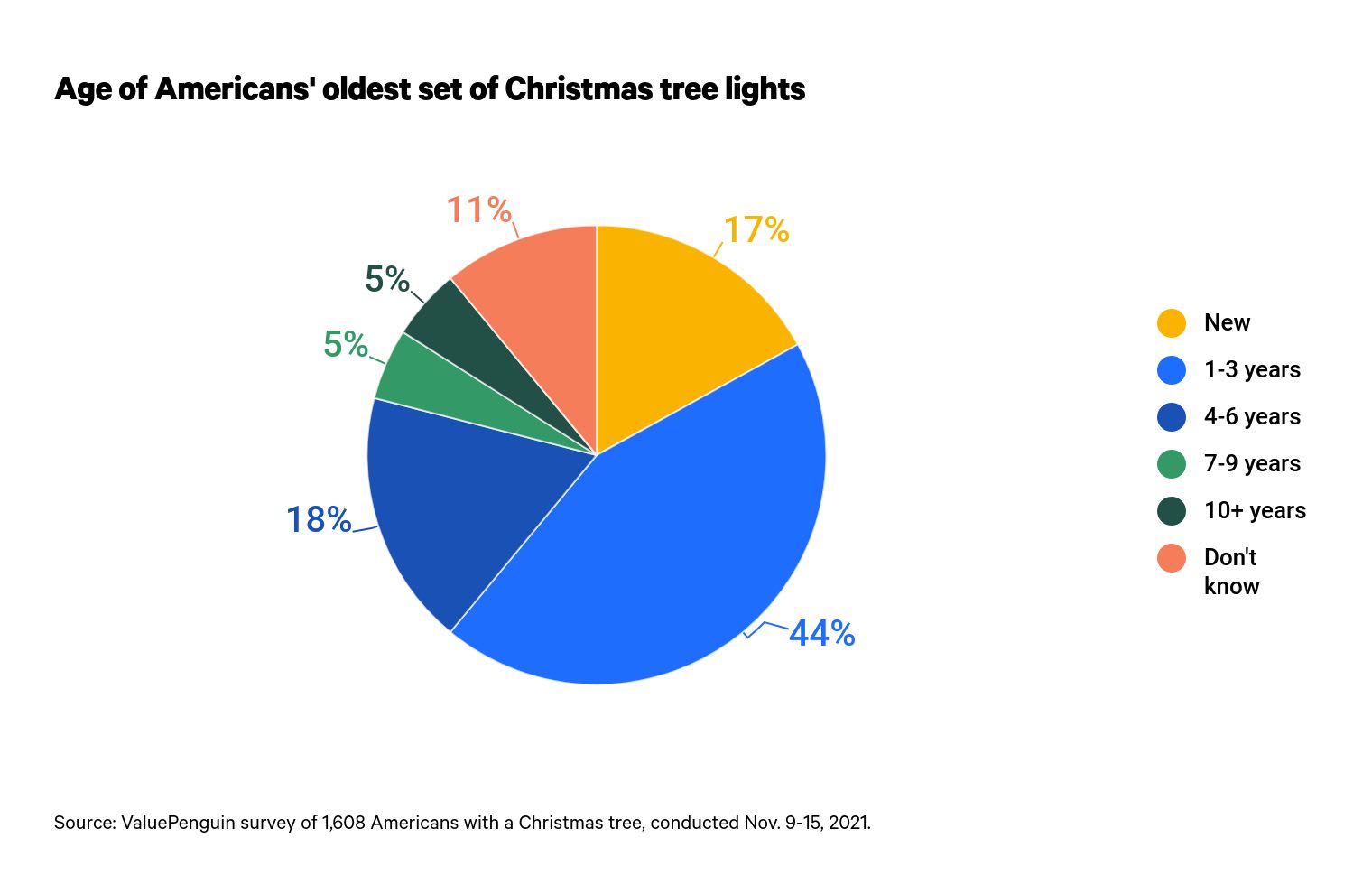
To help avoid light-related accidents, some consumers (24%) turn to smart home devices to manage their lights, led by:
- 34% of Gen Zers
- 33% of parents with children younger than 18
- 29% of Northeast residents
- 27% of men
So you might want to ask Santa for a smart home device that can help you deck the halls more safely next year.
What about Christmas trees and pets?
As much as you love your pets and want to enjoy the holiday season with them, they can cause some safety issues. Your pets mean well, but 72% of pet owners say their pets have knocked down their Christmas tree or knocked off ornaments. It looks like Fido might be getting a lump of coal in his stocking this year.
The outcome of this pet mischief? Nearly half (49%) of people in that same group report damage caused by their pets. Oops. It may be worth closing the door or finding a way to block them from getting near the Christmas tree when you can’t supervise their holiday behavior.
Rising utility bills could be real Grinch this holiday season
We’ve talked a lot about the damage holiday decor can do to your home and even your body, but it looks like your wallet can take a hit, too.
Because of rising electricity costs, 34% of consumers plan to use Christmas tree lights less often this year. This sentiment is shared the most by residents of the West (36%) and Northeast (35%), so some areas of the country will be shining a bit less bright than others this season.
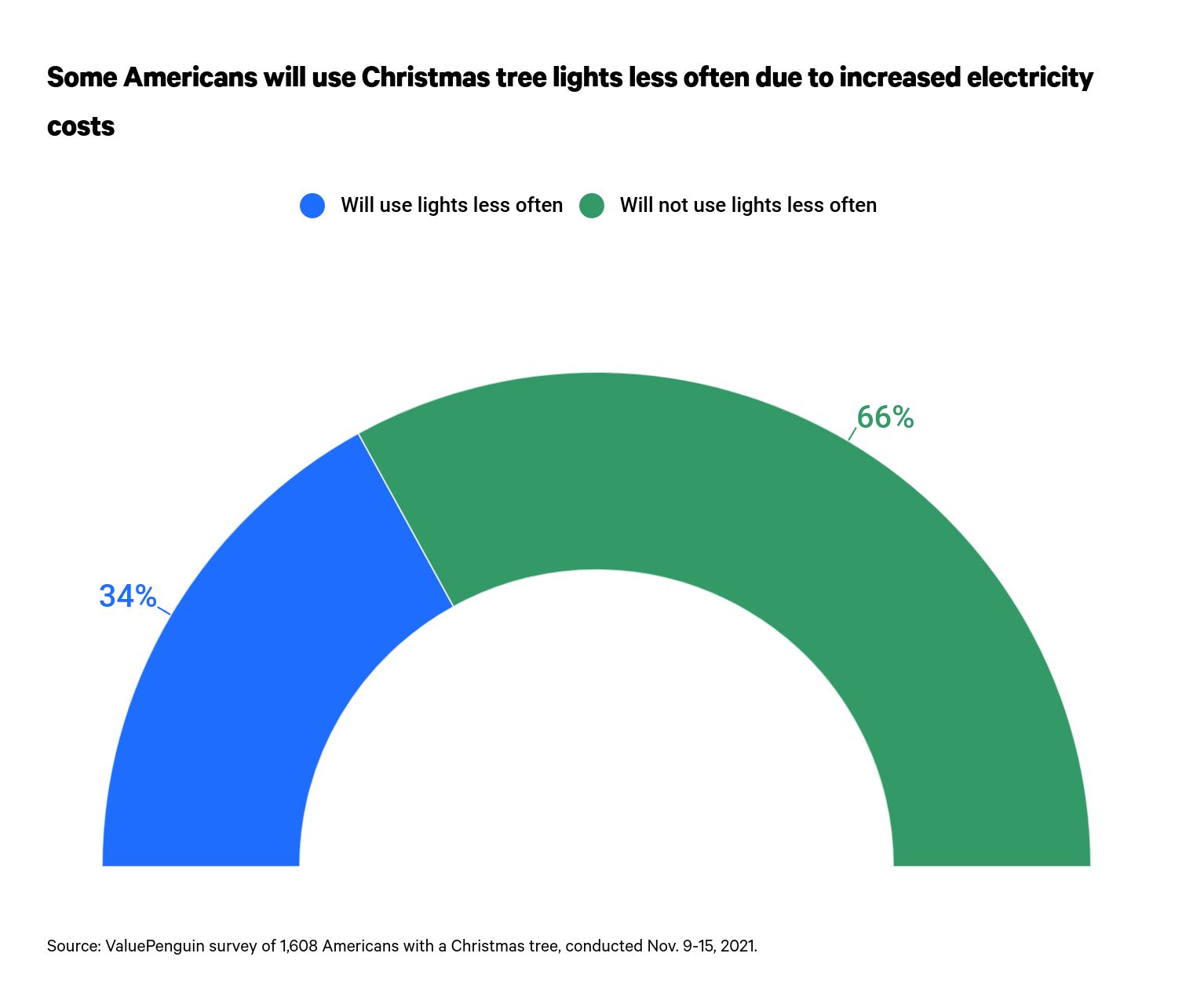
So why are electricity prices worrying so many consumers this year? Surging natural gas prices are causing energy prices to rise, and a higher electricity bill isn’t a fun expense to add to your monthly budget.
The pandemic also played a role in energy consumption and energy investments, affecting monthly electricity bills. We’re hoping Santa will bring us some lower utility bills next year, which will free up some room in our gift-giving budget.
Methodology
ValuePenguin commissioned Qualtrics to conduct an online survey of 2,050 U.S. consumers from Nov. 9 to 15, 2021. The survey was administered using a nonprobability-based sample, and quotas were used to ensure the sample base represented the overall population. All responses were reviewed by researchers for quality control.
We defined generations as the following ages in 2021:
- Generation Z: 18 to 24
- Millennial: 25 to 40
- Generation X: 41 to 55
- Baby boomer: 56 to 75
While the survey also included consumers from the silent generation (those 76 and older), the sample size was too small to include findings related to that group in the generational breakdowns.
